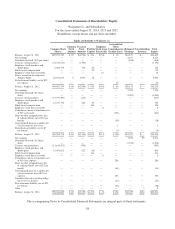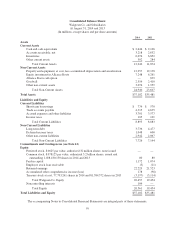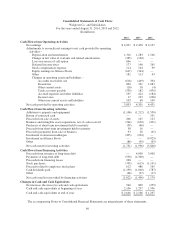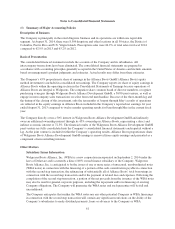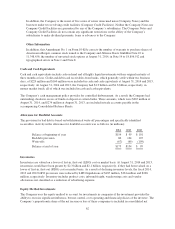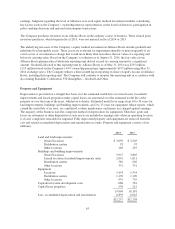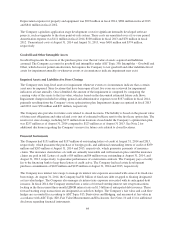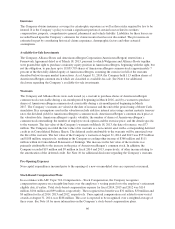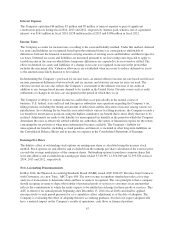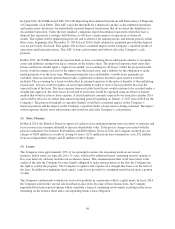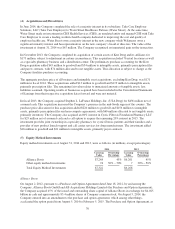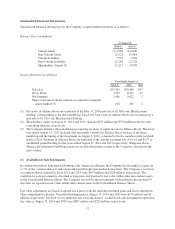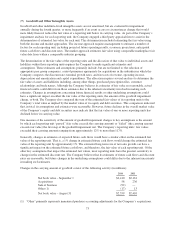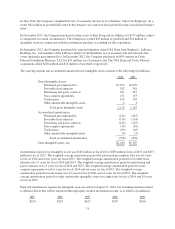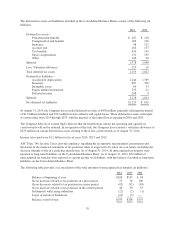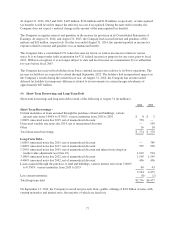Walgreens 2014 Annual Report Download - page 76
Download and view the complete annual report
Please find page 76 of the 2014 Walgreens annual report below. You can navigate through the pages in the report by either clicking on the pages listed below, or by using the keyword search tool below to find specific information within the annual report.In April 2014, the FASB issued ASU 2014-08, Reporting Discontinued Operations and Disclosures of Disposals
of Components of an Entity. This ASU raises the threshold for a disposal to qualify as discontinued operations
and requires new disclosures for individually material disposal transactions that do not meet the definition of a
discontinued operation. Under the new standard, companies report discontinued operations when they have a
disposal that represents a strategic shift that has or will have a major impact on operations or financial
results. This update will be applied prospectively and is effective for annual periods, and interim periods within
those years, beginning after December 15, 2014 (fiscal 2016). Early adoption is permitted provided the disposal
was not previously disclosed. This update will not have a material impact on the Company’s reported results of
operations and financial position. This ASU is non-cash in nature and will not affect the Company’s cash
position.
In May 2013, the FASB reissued an exposure draft on lease accounting that would require entities to recognize
assets and liabilities arising from lease contracts on the balance sheet. The proposed exposure draft states that
lessees and lessors should apply a “right-of-use model” in accounting for all leases. Under the proposed model,
lessees would recognize an asset for the right to use the leased asset, and a liability for the obligation to make
rental payments over the lease term. When measuring the asset and liability, variable lease payments are
excluded, whereas renewal options that provide a significant economic incentive upon renewal would be
included. The accounting by a lessor would reflect its retained exposure to the risks or benefits of the underlying
leased asset. A lessor would recognize an asset representing its right to receive lease payments based on the
expected term of the lease. The lease expense from real estate based leases would continue to be recorded under a
straight-line approach, but other leases not related to real estate would be expensed using an effective interest
method that would accelerate lease expense. A final standard is currently expected to be issued in calendar 2014
and would be effective no earlier than annual reporting periods beginning on January 1, 2017 (fiscal 2018 for the
Company). The proposed standard, as currently drafted, would have a material impact on the Company’s
financial position and the impact on the Company’s reported results of operations is being evaluated. The impact
of this exposure draft is non-cash in nature and would not affect the Company’s cash position.
(2) Store Closures
In March 2014, the Board of Directors approved a plan to close underperforming stores in efforts to optimize and
focus resources in a manner intended to increase shareholder value. Total pre-tax charges associated with the
plan are estimated to be between $240 million and $280 million. In fiscal 2014, the Company incurred pre-tax
charges of $209 million as a result of closing 67 stores; $137 million from lease termination costs, $71 million
from asset impairment charges and $1 million of other charges.
(3) Leases
The Company owns approximately 20% of its operating locations; the remaining locations are leased
premises. Initial terms are typically 20 to 25 years, followed by additional terms containing renewal options at
five-year intervals, and may include rent escalation clauses. The commencement date of all lease terms is the
earlier of the date the Company becomes legally obligated to make rent payments or the date the Company has
the right to control the property. The Company recognizes rent expense on a straight-line basis over the term of
the lease. In addition to minimum fixed rentals, some leases provide for contingent rentals based upon a portion
of sales.
The Company continuously evaluates its real estate portfolio in conjunction with its capital needs. In fiscal 2014,
the Company entered into several sale-leaseback transactions. In some of these transactions, the Company
negotiated fixed rate renewal options which constitute a form of continuing involvement, resulting in the assets
remaining on the balance sheet and a corresponding finance lease obligation.
68


